A Racing Expert's Take on the Technic McLaren P1 Hypercar

Today’s guest article comes from Scott Bowman, an engineer and racing official who founded ideaBRICKworks, who is taking an expert look at the 42172 Technic McLaren P1 on BrickNerd’s behalf.
An Engineer and a Racing Expert
I have been a fan of LEGO my whole life but only started seriously building in 2013. Ironically, it was the same year that the P1 came out. Since then, I have been heavily involved in LUGs, helping to start two of them in Iowa and Idaho; doing large community build projects involving kids at the Science Center of Iowa and STEM Moon Shot; building lots of sets; MODing lots of sets; and of course, creating lots and lots of MOCs. I am also a BrickNerd Patron (because why wouldn’t you want to support them?). But I don’t think that is why I came to their mind when LEGO offered them the 42172 Technic McLaren P1.
You see, I am a mechanical engineer who designed building systems for some 40 years—but I am totally and wholly a sportscar nut. My father is the cause of all this, having been bitten by the bug at an early age and infecting me.
I have been working, building, and racing sportscars my whole life. My first car was a 1960 Morris Mini which I had to rebuild from a bare shell starting at age 14. Since then I have restored two Porsche 914s and worked on many of my friend’s cars as well. My current sportscar and ongoing project of repair and improvement is a 2003 Porsche 996 C4S.

My father got me into the Sports Car Club of America (SCCA) when I was young, and I am still a member today. One aspect of the SCCA is Club Racing with purpose-built racecars competing wheel to wheel on winding road courses all over the country. I became involved in these races as an official serving in various volunteer roles on event weekends. Then with my Dad, I purchased a Sports 2000 racecar and competed for 13 years on an amateur level. I was not the fastest, but not the slowest either, and I won a fair share of national events. My superpower was finishing races by making sure my car was always ready to run and could last a whole event.


My career as an engineer helped me to afford this kind of hobby. But when my two incredible daughters wanted to go to college, my days of racing were over—but not my involvement.
I then started life as a Steward: a racing official who has various roles at a race event but is always in a position of authority for the safety and fairness of the competition. I rose to high levels in the SCCA, becoming the Executive Steward in charge of all racing in the Midwest. When I retired early, I shifted to professional racing. I started working with SRO Motorsports Group, which runs a series called World Challenge, racing the best-performing sports cars in the world!
I am in the tech department as a scrutineer. Scrutineers inspect the cars to confirm compliance with series rules and standards. I get up and close with the cars as they come off the track in parc fermé and do close inspections and measurements in an official role. This is incredibly fun but can be challenging, as the push and pull between competitors and officials is often tense. Age and experience are my tools when dealing with the inevitable conflicts that arise from this high level of performance and competition.






Race photos used with the permission of SRO Motorsports Group.
Not only do I know LEGO, but I know sports cars—specifically Grand Touring (GT) cars. My look at the Technic McLaren P1 will be more about my connection between real life and LEGO. This will be an expert look at the new LEGO “supercar” by the ultimate LEGO and car fan! Recently, SRO started a GT1 Sports Club for cars just like the McLaren and Ferrari. This turned out to be a great way to see these incredible machines in person and on the track. They are scheduled to be at more races in 2025.
Hypercar History
Now that you know my chops, let’s discuss the model. While I do not design or build MOCs in Technic, I love what fans call the Technic supercar series, officially called the LEGO Technic Ultimate Car Concept Series. I now have three of them, with the Porsche 911 GT3 RS and the Ferrari Daytona SP3. (The Bugatti and Lamborghini are not brands that appeal to me, and with the high cost of these beauties, you have to really love the car brand to buy and build them.)
For some clarification: I will be using the term “hypercar” instead of “supercar” in this article. LEGO fans use the term supercar, but in the automotive world, the McLaren P1 and similar cars are called hypercars or GT1s. They all describe cars that are at the pinnacle of performance, form, and of course, cost.



Having a few of these models gives me a view of the series’ growth from the Porsche in 2016 to the McLaren eight years later. There has not just been an increase in parts (from 2,700 to almost 3,900) but an increase in sophistication. As you can see, the body of the Porsche leaves much more to the imagination than the Daytona (released in 2022) and the new McLaren.
As a kid growing up, I built 1:24 scale plastic models, making lots of modifications and improvements with lots of paint and glue and all things messy. For me, these Technic sets have given me the same feeling of building a well-designed model, now with no mess or fuss! And if you make a mistake, you can correct it and still modify and improve the build, even years later.
These Technic hypercars are really a prestige building experience, starting with opening the box and looking at the instructions. I remember so many years ago, waiting anxiously for the Porsche and being blown away by the packaging! It truly was next level, and the McLaren is no disappointment, raising the bar significantly.




Yes, I used a Speed Champions McLaren F1 as a wedge to hold the box!
The instructions are also so much more advanced than the Porsche. The information about the company, the car, its history, and the design are very well done. There are some fun pictures of the design process with all sorts of previous versions, some made from any color they had around, just like many do when MOCing. There are lots of call-outs to assist in building it correctly, including some side and top views to allow you to compare what you have done and make sure the section is built correctly.
Another quick observation: there are no stickers! Only printed bricks are used for the set, similar to the Daytona. The Porsche had quite a few stickers with their printed elements.




Source: Brickset
One interesting thing that caught my eye is that the Director of Product Strategy at McLaren mentioned the 8860 set as his first Technic set, which was the same for me! I was still in high school when the 8860 Car Chassis came out, and my parents got it for me as they had not seen something like it before. I still know exactly where the wheels are in my collection, so I am sure all the bricks are still around somewhere. Maybe I should build it again!
Before the McClaren P1 set was announced, those involved in the speculation on what the 2024 Technic model would be were convinced LEGO would not repeat a supercar color. Technically, they did not. The Porsche is Orange, while the McLaren is Bright Light Orange. Orange has been the color of McLaren since 1967. While there seems to be no specific reason for this becoming their signature color, some think McLaren founder Bruce McLaren wanted a national racing color for New Zealand.
Red has been the color of Ferrari (Italy), silver for Germany, green for Britain, blue and white for the United States. Frankly, the orange Porsche was a controversial choice at the time, as this was quite unusual for the brand. While silver is a very German color, having a full Light Bluish Gray Technic car would not have been very appealing. White or red would have been my preference.
The first box and first bag already show how this is an experience, not just a build. This is the first set, for me at least, that has almost exclusively paper recyclable bags—even the little internal ones. This is a great change, and I am happy to fill my recycling bin faster than my trash!

Opening some of the bags, a couple of parts stood out to me: a true wishbone suspension arm (new to this kit) and detailed coil-over shock absorbers. These shocks are really wonderful, and they were in the Daytona as well. They are very similar to what real-world shocks look like. Now, could LEGO make the height adjustable, just like the real ones? That would solve one of my major concerns for all Technic builds: the ride height. More on this later.

Internals and Mechanisms
Getting started with the build, the first thing you make is the limited-slip differential. Not to get too in the weeds, but a differential allows the driven wheels to rotate at different speeds when a car is turning. While turning, the outside wheel will rotate farther than the inside one—which if connected by a solid axle, would rub. Back in the day when wheels were made of wood, one of the two wheels would slip. This is not a big deal when you are going only as fast as a horse.
The problem with a pure differential is that if one wheel starts to spin, all the power will go to that wheel and the car stops moving, which we call slip. There are different types of limited-slip systems, and LEGO has created one of the best: a fully gear-driven Torson, representing the highest performance and efficient version. Try spinning the two axles differently and you will feel the resistance which will maintain power to the wheel with traction while the other slips.



There are so many great parts of this build, it is difficult to list them all! I will flag those I think most interesting and you can look at more of the build in a gallery at the end of this section.
This is part of the 7-speed transmission. In the real car, the PDK unit was a Porsche-sourced unit that was an established high-performance racing unit that used paddle actuators. The battery pack in the car is located behind the seats, so the LEGO version is located here which was a great solution to maintain the shape of the car AND demonstrate how this kind of transmission works.

7-Speed Transmission
The heart of any racing transmission that uses linear actuation (forward and backward movement versus the classic H pattern shift knob) is a selector barrel. The two orange round parts on each side of the engine model these barrels and actuate shifter forks to change gears by changing which gear shafts are connected to the engine and differential. There could be a whole article on how the LEGO elements represent real-life components, so I will leave this at how impressed I am with the authenticity of this design and the layout of the transmission.


An added benefit of the two barrels in this position is they represent the dual turbochargers that are on both sides of the engine! In this case, LEGO used function to show the form!
Here are two locations where bands are used to provide paddle shifting. In the first, the bands are located at the steering wheel and the other is near one of the selector barrels. Both show how a gear is held in a specific position and then make a positive change one tooth with each activation. Simply brilliant, and I say that as an engineer!


One thing, I am disappointed by an aspect of the transmission. The paddle shifter does not stop. Normally, this kind of transmission will go through the gears starting in neutral and ending with the highest gear. Then you have to use the down paddle to go back. The Daytona has this built in. In the Porsche, a MOD had to be made to create this stop.
The unique printed plate is a fun addition to the series. The Daytona had this, but the Porsche did not.



The use of the original shock absorbers to hold open the doors (which was also used in the Daytona) is well done. In engineering terms, this is a self-locking four-bar linkage. I still remember this from so many years ago when I was in college. In my statics class (which applies to linkages), we were asked to find a four-bar linkage, and I detailed a Vice-Grip wrench that I used working on cars! The professor loved the example and had not seen it before. The images show the two positions, opened and closed.
The interior is very well done. Perhaps more of the parts under the dash should be black, but the two yellow paddle arms really show off the function of the shifting. The Daytona is similar, but the paddles are black, so are hard to see. One other note, the McLaren does not have a HOG (Hand of God) connected to the steering, which is just fine with me. One modification I made to the Daytona, and any build that has one, is to remove this feature. For me, models are for display and to show off the features. It is easy enough to turn the front wheels.


Images of comparative parts come from Driveline
Now, I have a very different way of building any LEGO car. As soon as the build has all four corners and can support its own weight, I jump to the end and add the wheels and tires. Always! After Bag 14, step 635, the chassis was ready for wheels, so I jumped to visit the last few steps, starting at 996! I also installed the brake calipers. The way these are installed (via printed bricks, of course) is well done and much better than what was done in the Porsche. The wheels are cool as well and very realistic.
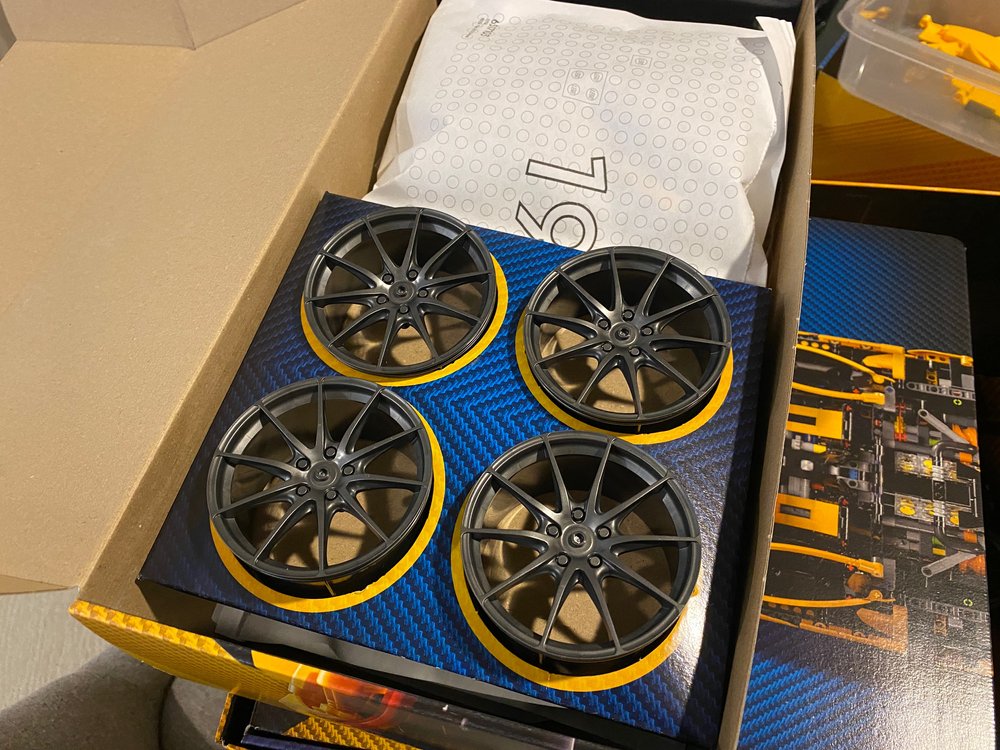





The newer brake disks, shown with dimples to represent the drilled rotors of the real things, are much better than the Porsche, and I like them very much. However, they are not quite big enough. Below are a couple of examples of rotors and calipers of real GT cars; they fill the wheel and are massive.


Adding Some Color
While others will do a better job identifying new parts, both of these were new to me and were key to the very realistic undertray, spoiler, and door. It will be fun to see where these get used next.



The door and hinge work pretty well, guiding the upper trim over the windscreen helps. One thing this set improved was the closing function of the door. On the Porsche and Daytona, there was nothing holding the doors in position when closed. I added working door latches on the Porsche (using an original shock absorber) which works well. On the Daytona, I added a landing for the door when closed that keeps it in a good position, very similar to what LEGO did as shown in the picture by a white arrow.
The image below of the real car shows the carbon fiber chassis of the car. See more on this later in the article.


Here is the finished set… and it is most impressive. The representation of the car is the best yet in the series. As I said earlier, I have never liked the ride height of the previous models, but this one is perfect. Well done, LEGO! No modifications are needed (like I had to do on the Porsche and the Daytona). The nose and frunk (front trunk, common to the Porsche and Daytona) are some of the best features and, again, are very close to the actual car.



The front of the car is very distinct and has rather unusual lights. This has been recreated by LEGO with a unique use of a white claw. Doing a little research on the “Swoosh” (a little too close to Nike if you ask me), it turns out that McLaren calls this the “Speedy Kiwi.” Bruce McLaren was a truly gifted and talented engineer and driver. He was born in New Zealand and wanted a connection to his homeland.




The rear cover of the engine of the P1 is not hinged or easily opened. LEGO has replicated this feature. You have to take off the wing and loosen two technic push pins, then you can lift the cover off the car. The rear wing is actuated on the real car and is replicated in the model, which needs to be deployed at high speeds to increase downforce.



So, why are there two hinged Technic panels near where the back panel meets the roof? Well, it turns out they are access panels. The one on the left is for gasoline, and the right is for charging the battery of the car. This is one area that I would like to modify and add some representation of this function below these panels.
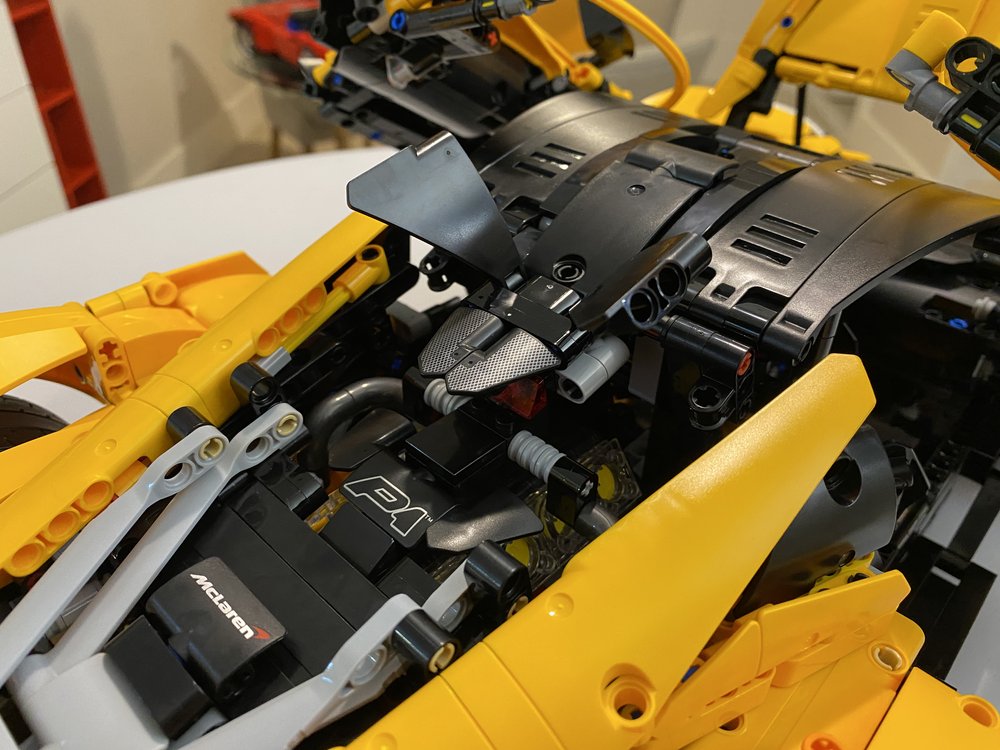

Here’s my final take on the LEGO Technic McLaren P1 in a nutshell: Awesome! Worth every penny. Super fun to build. Really an amazing model.
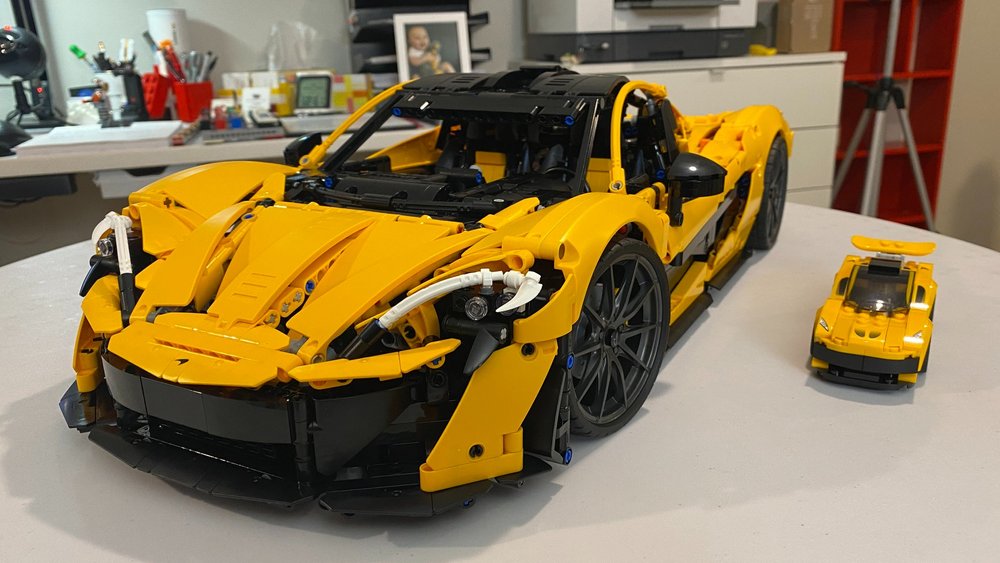
And here is a full gallery of build images for your perusal:


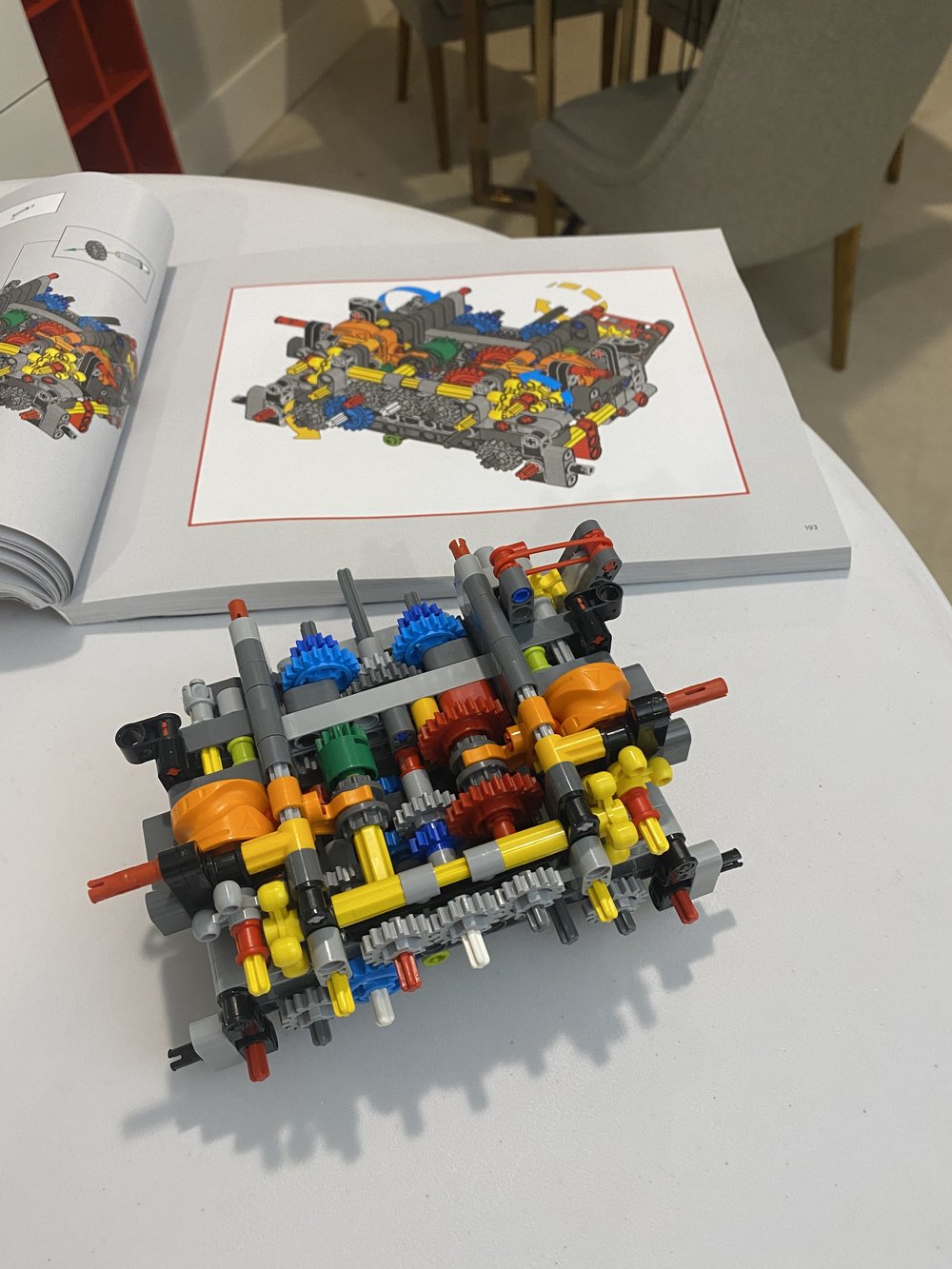














Hypercar By The Numbers
What makes a car a hypercar? Performance is obvious, and it has to be stellar and/or best of class. Technology has to predict systems or features that will be common in 10 to 15 years. Most importantly, it has to be incredibly rare and expensive. Mere mortals will only get as close as pictures, models, die-casts, or wonderful Technic models! The McLaren P1 ticks all these items and more.
Let's put some numbers aspects of the three cars I have discussed, including some details from the associated LEGO sets.
|
McLaren P1 |
Ferrari Daytona SP3 |
Porsche 911 GT3 RS |
|
|
Year Released |
2013 |
2022 |
2016 |
|
Number Made |
375 |
599 |
4,500 |
|
Total Horsepower |
903 |
830 |
490 |
|
0 to 60 mph in seconds |
2.8 |
2.8 |
3.4 |
|
Top Speed, mph |
217 (limited) |
211 |
193 |
|
Weight, lbs |
3,200 |
3,300 |
3,100 |
|
Cost when new |
$1,200,000 |
$2,250,000 |
$180,000 |
|
LEGO Release Year |
2024 |
2022 |
2016 |
|
Number |
42172 |
42143 |
42056 |
|
Pieces |
3,893 |
3,778 |
2,704 |
|
Price when Released |
$449.99 |
$499.99 |
$299.99 |
There are some really interesting aspects of the McLaren that are worth highlighting. Some are mentioned by LEGO in the instructions, but there is so much more.
At over 900 hp, the power of the P1 is incredible. Now, this is a combination of the internal combustion engine (ICE) and two electric motors. One electric motor is located under the ICE unit, and the other is up front driving the front wheels (which is not really shown in the LEGO version). The very sophisticated computer controls balance all these inputs to maximize the transfer of power to move the car. When exiting turns, for example, it will engage the front wheels to help pull through the corner while controlling wheel spin at the rear to maximize exit speed.

Source: MotorTrend
We normally think of a hybrid car as increasing efficiency and fuel mileage. For the P1, the electrical system is only for performance. There is no regenerative braking, which typical road cars use to charge the batteries and extend battery life. The batteries in the P1 are charged by the engine and kept as high as possible based on the mode the car is in.
The McLaren P1 was one of the early road cars made completely from carbon fiber. Carbon has been the go-to tool for the fastest racecars, like Formula 1 and IndyCar. However, the current production process is very labor intensive, so the cost is quite high. The performance benefits are significant. Not only is carbon fiber much lighter than steel or aluminum, but it is also five times stronger than titanium. This gives a rigid and light frame from which the suspension can maintain a grip on the road and the aerodynamic loads to push down. Also, it just looks super cool!
Computers are key to the performance of any hypercar. There are many tools available in the cars to handle all driving dynamics needed depending on the goals of the driver. Do you want to maximize acceleration? Battery Boost will shift the electric power to acceleration. Torque is required to accelerate which is almost infinite with electric motors. Want to test out that top speed number? Use Aerodynamic Boost to reduce total drag on the car. Friction with the air is the major load when going fast, which requires large horsepower. Be careful, though—it can make the car a bit sketchy to drive. Doing a track day at somewhere like Road America in Wisconsin? Switch into Race Mode to generate 1,300 lbs of downforce and stiffen the suspension by six times.
Why do I mention Road America? This 4-mile road course has three straights where cars get to their maximum speed. But if you want to get a good lap time, you have to manage some of the toughest corners in the world. This is my favorite track, and I have raced on it many times over many years. My Swift DB2 racecar could reach its maximum speed three times, about 165 mph, with only about 150 hp! I am sure the McLaren P1 in the right hands would easily reach 200 mph there.

Source: Road America
Cars that go very, very fast need to be able to stop very, very well. In the McLaren, the brakes are carbon-silica, one of the hardest materials on earth. This provides incredible stopping power, which leads to faster lap times when on a road course. Brakes like these have one drawback: they need to be really hot to work best. It is hard to get this heat into the brakes in normal road use.
One fun aspect of the car is the body. Most of the panels that have color are removable and changeable. Want a red car? You can buy a set of panels for $250,000 and swap them out! Match your car to your mood.
What about the top speed? As indicated above, McLaren has limited the top speed to 217 mph (350 kph). This is typically done by manufacturers due to the tire technology needed at very high speeds. Tires for a P1 could cost as much as $10,000 just for the rubber and so much more to install due to the complexities of balancing and adhesion to the wheel. The Bugatti Chiron (another LEGO hypercar) has been driven at 305 mph, but required 1,500 hp and incredibly expensive tires to do it!
Real-Life Connections
My motorsports life does intersect with McLaren’s. Currently, there is a McLaren Artura in the GT4 class of SRO. This car has the genes of the P1 but is simplified to be at lower performance levels and a lower cost. The street car version starts at $240,000, and the race car version is much higher (but rarely disclosed). This is an incredible car and quite fast in the right hands. This is a new team to the series and a brand-new car, so they are working through development issues but are getting faster at each event.
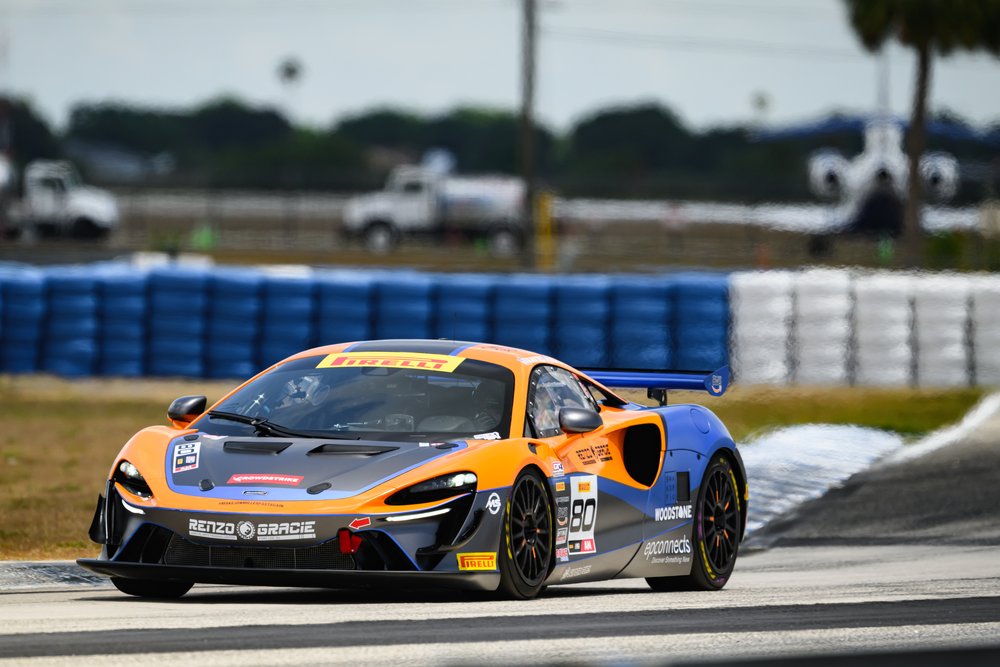
In my role as scrutineer, I have been able to inspect this car closely inside and out. While I have not ever seen a P1 in person, this car is pretty close and is very impressive. With the full roll cage, racing seat, and safety equipment, it is very tight and a bit claustrophobic. The technology of the P1 is amazing and after building this set, I will be looking closer at this car.

Source: McLaren
In 2025, SRO will be adding a new series, the McLaren Trophy America championship. This will be what is called a single-make series, where all the cars are the same, in this case, a new Artura racing version that will be based on the GT4; but changed in ways to control costs and support that is typical for this kind of racing. Single-make series have high levels of performance but focus on preparation and the drivers. Teams with talented drivers, engineers, and crews thrive in this kind of event. It will be exciting for me to work with these cars next year!
LEGO and McLaren
This is not the first McLaren that LEGO has produced—in fact, they have a whole McLaren lineup of Speed Champions, both 6-wide and 8-wide, and Technic builds, too. Here are a few that I have, including the 6-wide version with its big brother! Of course, I had to make a 6-wide version myself to go with the Porsche!



LEGO and McLaren have collaborated on some slightly larger projects, too. Here is a life-size version of the McLaren Senna, a more recent hypercar from the make released in 2017. This is named for the famous Ayrton Senna, a multiple F1 World Champion and arguably one of the greatest drivers of all time. Senna drove for McLaren for six years, winning 35 races and three world championships. This is a picture taken by a good friend at Goodwood Festival of Speed in 2019 in the United Kingdom. Truly remarkable.
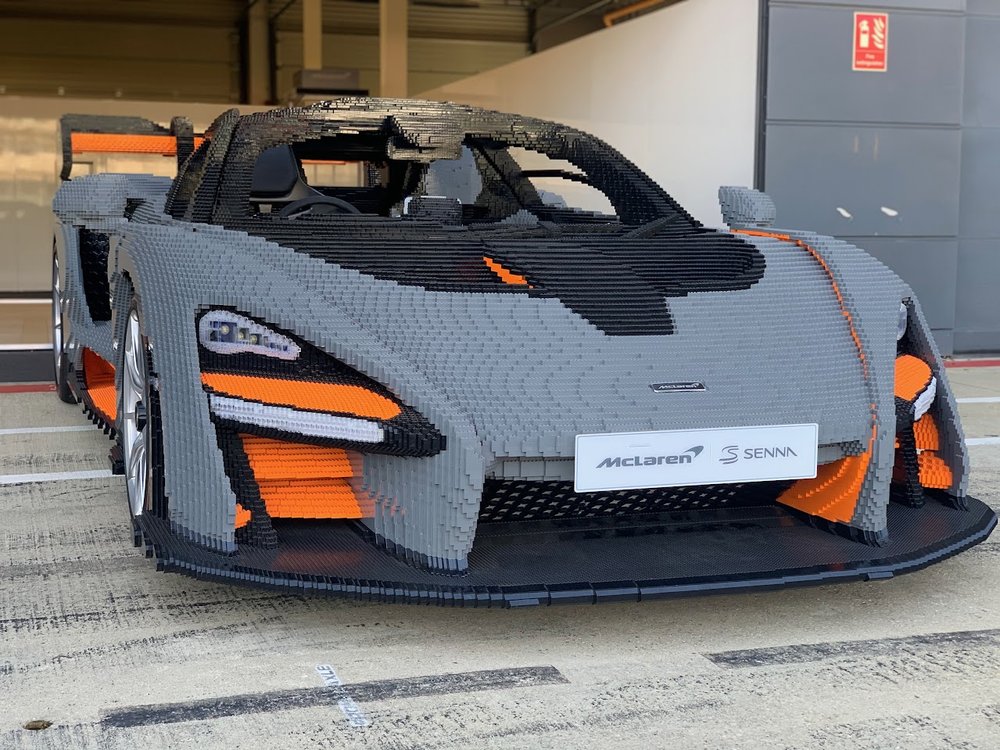
And that is not the only one LEGO has done—they did a full-size 720S at Goodwood in 2017 and a full-size Formula 1 racecar, the MCL36, in 2022!

source: Ryan McNaught
My LEGO Life

Let’s take a bit of a quick detour before we cross the finish line. In 2015, when I retired early as a principal and owner of a large, multi-discipline engineering firm, I started a company called Integrated Design + Energy Advisors, LLC, or IDEA for short! Also known as ideaBUILDworks, I did consulting and education centered around high-performance buildings, sustainable design, and resiliency.
This company also had a DBA called ideaBRICKworks, where I started to design and sell custom building kits using LEGO elements, take commissions for brand enhancement through activities and/or custom builds and kits, and create and administer large engagement events, using LEGO, of course. I also sometimes sell directly to the public at events. (If you feel moved, please visit my Etsy store and see what I have available. Most of my kits are space or racecar-related. I also have some popular Christmas kits.)
I also love displaying my work at LEGO conventions. Here is my display with the Charm City LUG at the 2024 BrickFair Fredericksburg event. Space was a little cramped as you can see, but it was a lovely event and quite fun.






Yes, that rather large Saturn V is mine. This 12’ tall, 40,000 brick model of the moon rocket was constructed with the help of 1,500 kids (and BrickNerd’s chief editor Dave plus the awesome folks of SeaLUG) as part of a program that I titled STEM Moon Shot. This means I have 1,200 pages of instructions for the monster! But that is for another story.

For reference, this is my most popular building kit, the Micro Saturn V, which I developed for STEM Moon Shot and is still available today. I gave 3,000 of these to kids at two events, but I have also sold another 1,000 or so all over the world.
My move to Maryland also allowed me to expand my studio quite a bit. You can see below that I must have a cluttered mind since my space is quite messy right now. Besides writing this article, I am preparing for BrickFair Virgina in August. The rather large tower on my central table is a CyberPunk build that is part of a community build with the Charm City LUG. With lots of work left and so little time, I may need to find a couple of collaborators to help me finish it up!





The Finish Line
Thank you for reading to the end! I want to thank the whole BrickNerd team for this opportunity. The work they do is incredible and always interesting. Who knows, maybe they will ask me to do another project at some point!
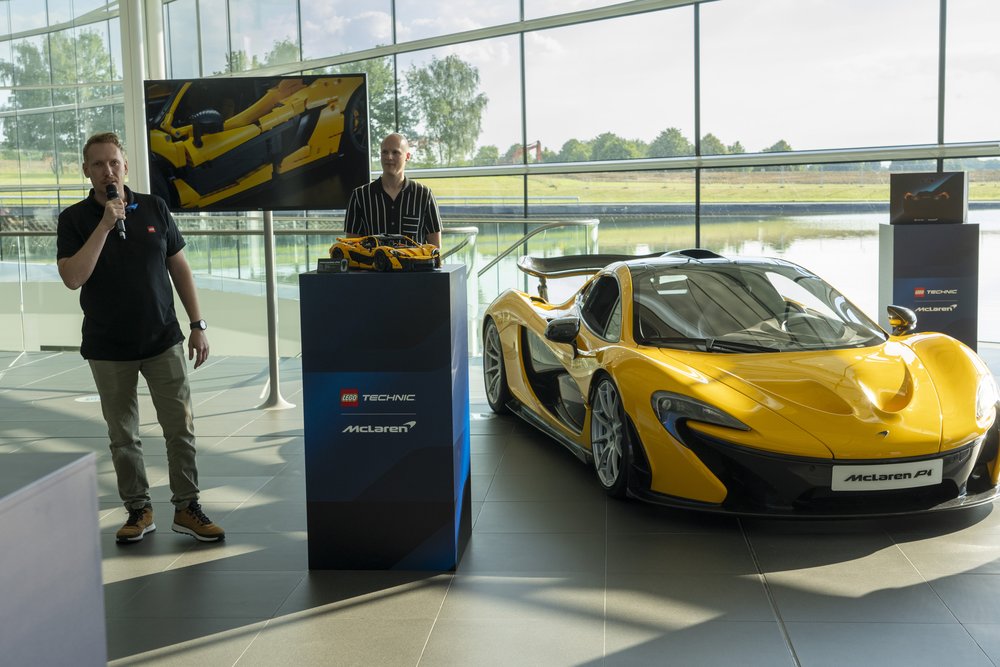
IMage via LEGO
As I finish this review, I am packing and getting ready to leave for my next race at Virginia International Raceway. This will be the only race that I can drive to, so I am going to be taking the McLaren with me to show all my friends and take some epic images of the car next to real hypercars! LEGO creates great sets, and I look forward to the next Technic supercar.

The 42172 Technic McLaren P1 will be available starting August 1st for $450 US, $590 CAN, and £390 UK.
DISCLAIMER: These sets were provided to BrickNerd by LEGO. Any opinions expressed in this article are those of the author.
What do you think of the new McLaren P1? Did you learn anything about real hypercars? Leave your thoughts in the comments below!
Do you want to help BrickNerd continue publishing articles like this one? Become a top patron like Charlie Stephens, Marc & Liz Puleo, Paige Mueller, Rob Klingberg from Brickstuff, John & Joshua Hanlon from Beyond the Brick, Megan Lum, Andy Price, Lukas Kurth from StoneWars, Wayne Tyler, Monica Innis, Dan Church, and Roxanne Baxter to show your support, get early access, exclusive swag and more.

